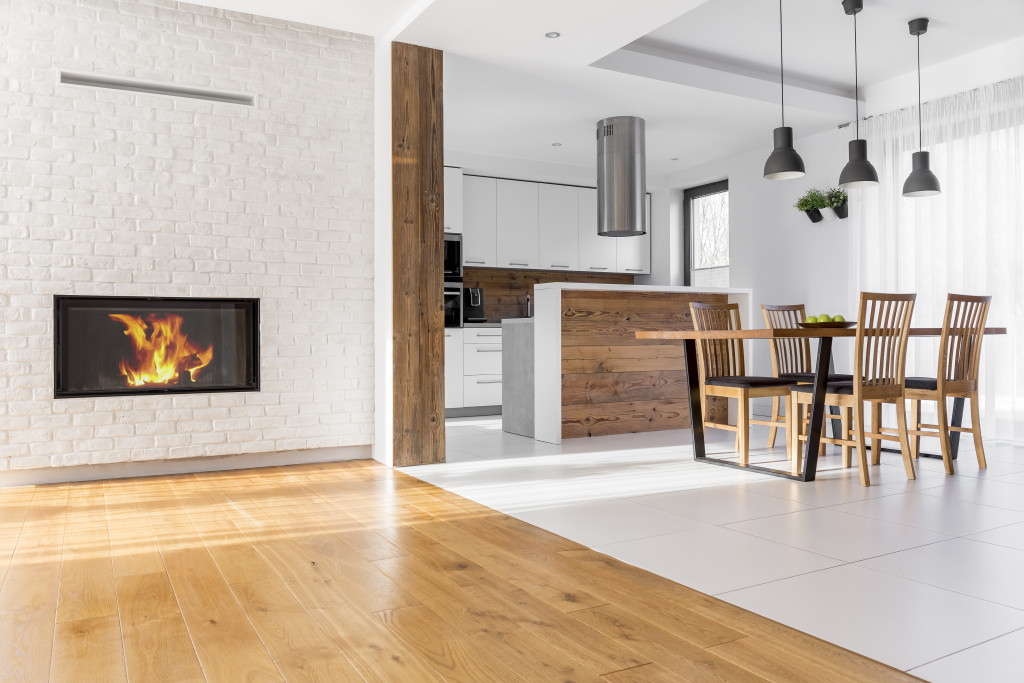- Create a unified color scheme to achieve a visually pleasing and harmonious aesthetic.
- Invest in high-quality and comfortable furniture for longevity and luxury.
- Elevate the lighting design by incorporating a multitude of light sources to create a versatile ambiance.
- Incorporate textures and patterns to add depth and interest to the interior design.
- Use overlap reducers for seamless transitions between different flooring types.
Creating a home that feels as good as it looks requires careful planning and attention to detail. A harmonious and comfortable living space can significantly enhance your quality of life. Here are five practical and inspiring tips to elevate your interior living space.
1. Implement a Cohesive Color Scheme
Choosing a color scheme that reflects your style while creating a cohesive look is fundamental. Start by selecting base colors for walls and significant pieces, then incorporate accent colors through accessories and artwork.
Your chosen palette should resonate with your aesthetic preferences and evoke the desired mood and atmosphere in each room. Understand the psychological effects of colors and use them to craft calming, energizing, or focused spaces as needed.
2. Invest in Quality Furniture

Select furniture that combines functionality, comfort, and style. Investing in high-quality pieces ensures longevity and adds a touch of luxury to your living space. Consider the scale of the furniture about the room’s size to create a balanced look.
Quality furniture is not just about aesthetics; it’s about comfort and durability, too. Select pieces that offer support and are made from durable materials to withstand daily use, ensuring your investment is worthwhile in the long term.
3. Enhance Lighting Design
Lighting plays a crucial role in establishing the ambiance in your home. To create a dynamic and adaptable environment, incorporate various lighting sources, including ambient, task, and accent lighting. Adjust lighting levels to suit different activities and times of the day.
Implementing a layered lighting approach allows you to highlight architectural features and artwork while providing functional light for reading and other tasks. Invest in adjustable and energy-efficient lighting solutions to tailor each room’s atmosphere while saving on energy costs.
4. Incorporate Textures and Patterns
Using a mix of textures and patterns adds depth and interest to your interior design. Incorporate different materials through furniture, textiles, and accessories to create a layered and inviting look.
Here are tips to incorporate textures and patterns:
Balance is Key
Striking a balance between different textures and patterns is key when incorporating them into your interior design. Too many bold patterns can overwhelm the space, while too many soft textures can make it look bland. Try combining bold patterns with softer ones and mixing rough textures with smooth ones to create a balanced look. For example, pair a heavily patterned rug with a solid-colored, smooth-textured sofa.
Use Textures and Patterns to Define Spaces

Textures and patterns can effectively define different spaces within a room. For example, a patterned rug can delineate a sitting area within a larger room. Similarly, textured wallpaper can create a focal point or highlight a specific area in the room. Use textures and patterns to create unique, defined spaces in your home.
Consider the Room’s Purpose
The function of the room should guide your use of textures and patterns. For instance, in a bedroom, you might want to use softer textures and calming patterns to create a peaceful, relaxing atmosphere. On the other hand, in a living room or study, bolder patterns and textures could stimulate conversation and creativity.
Don’t Forget the Floor and Ceiling
Often, when decorating, you focus on the walls and forget about the floor and ceiling. However, these surfaces offer great opportunities for incorporating textures and patterns. A textured rug or a patterned ceiling can add a whole new dimension to a room. Just remember to keep everything cohesive with the overall design scheme.
5. Seamlessly Transition Between Flooring
As you move from room to room, the flooring should offer a seamless transition, enhancing the flow of your home. This consideration is especially crucial when dealing with open floor plans with visually connected spaces.
An overlap reducer can be an invaluable tool in achieving this smooth transition between different types of flooring, especially if they are at different heights. Using an overlap reducer ensures a smooth and seamless transition from one flooring type to another, preventing tripping hazards while maintaining an elegant and cohesive aesthetic throughout your home.
In Closing
Elevating your living space is a thoughtful process that combines aesthetics with functionality. From selecting a color scheme to ensuring seamless floor transitions with tools like overlap reducers, each detail contributes to creating a home that is not only visually pleasing but also comfortable and safe.
With careful planning and a keen eye for design, you can transform your living space into a true reflection of your style and personality, offering a welcoming and harmonious environment for all who reside or visit.

